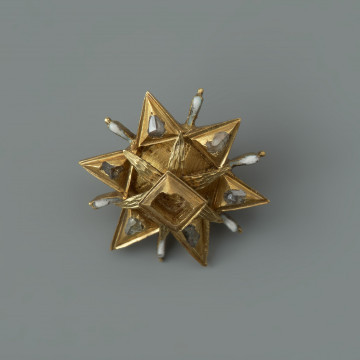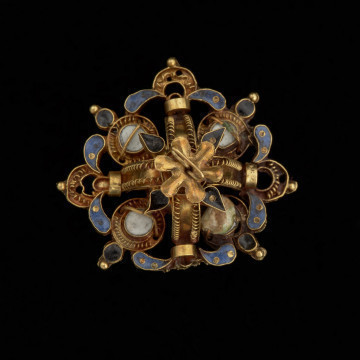
Star-shaped dress jewellery
nie po 1637
National Museum in Szczecin
Part of the collection: Jewels and costumes of Pomeranian dukes
The rosettes from the cap of Duke Francis I of Pomerania have been preserved in various states of conservation: four of them have pearls, one is missing a diamond, and two have broken off the earrings. In addition, one of four elements of a flower with a diamond is missing from the clasp. Significant differences can also be seen in the state of preservation of the enamel: from very good to residual. The comparison of rosettes allows us to understand how important this type of decoration played in 16th- and 17th-century jewellery. Colour enriched and plasticised the composition; in the case of transparent enamel, the expressive colour accents were often close to the effects produced by precious stones, and grooved enamel allowed even small surfaces to be decorated with delicate, graphic ornaments. The decoration of Francis I's cap was mainly based on groove enamel (champlevé). The ornamentation consisted of chiselling hollows and grooves into the metal surface, then filling them with enamel and firing at a temperature below the melting point of gold. After cooling, the object was polished until a smooth surface was achieved. In the rosettes with enamel defects, you can see how the parts were prepared for enamel: the goldsmith, making indentations, left those walls that formed a gold ornament on a colourful background. Many shades of enamel were used in Szczecin's rosettes. They are dominated by transparent ruby red, white, blues and greens, both in opaque and transparent versions.
Monika Frankowska-Makała
Dimensions
cały obiekt: height: 2,3 cm, width: 4,2 cm
Object type
headgear adornment, jewellery
Creation time / dating
Creation / finding place
Identification number
Location / status

nie po 1637
National Museum in Szczecin

nie po 1637
National Museum in Szczecin

około 1600
National Museum in Szczecin
DISCOVER this TOPIC
National Museum in Lublin
DISCOVER this PATH
Educational path